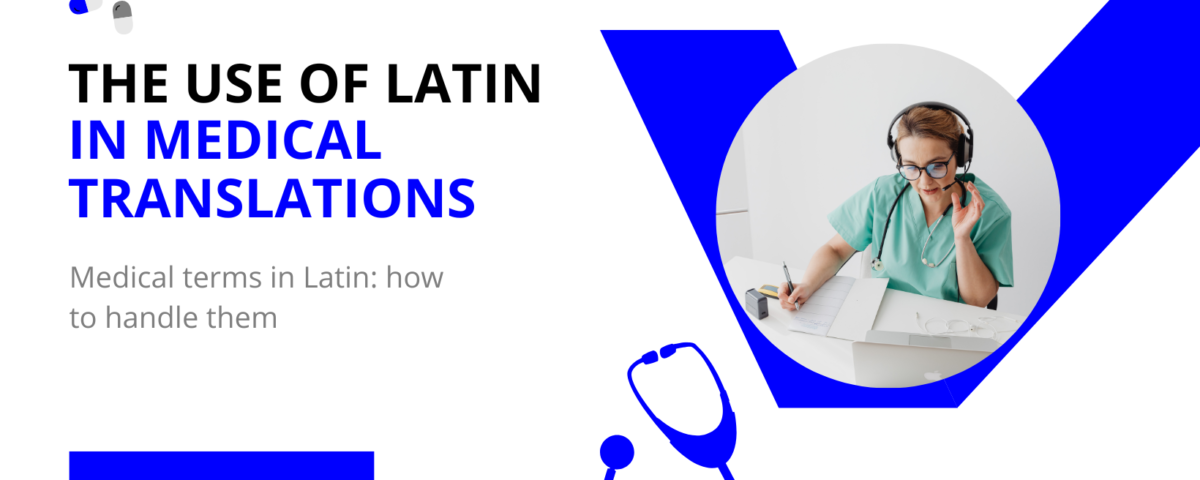Latin is still the language of medical terminology. From medical reports to name to the name of the diseases, we find lots of terms originating both from Latin and Greek.
In this short blog post we will cover how a translator should behave while translating an English medical report containing Latin terms.

So why is Latin used in medical jargon?
Research revealed that the use of Latin fully complies with the communicative strategies of medical case reports as a genre. Owing to the fact that Latin medical lexis is internationally adopted and understood worldwide, it promotes the conciseness of medical case reports, as well as contributes to their narrative style and educational intentions. Secondly, Latin and Greek medical terms have been acquired in many languages.
Indeed, many medical terms for diagnoses, pathologies, pharmacology, and anatomical parts are derived directly from Latin. We can say that medical terms are somewhat universal, making it easier for doctors and scientists to communicate. Although new terms are frequently introduced and shared in English (by-pass, pacemaker, check-up), English uses the Latin versions for many anatomical parts ( eg: alveolus, aorta, appendix, ileum, pelvis, urethra) and for pathology and agents: (e.g. virus, lichen planus, lupus erythematosus).
According to Banay GL., approximately 95% of English terms are borrowed from or created on the basis of Latin and latinized Greek. Therefore, the English medical terminology cannot be “reasonably mastered without the knowledge of basic Latin”.
How do we deal with Latin medical terms?
Medical reports necessitate knowledge of medical jargon from a translation standpoint. A good command of Latin could aid and facilitate comprehension of this type of text. First and foremost, we would like to emphasise the importance of understanding the target audience: it is possible to translate a document directly for a patient, in which case the language can be simplified. If the end users are doctors or scientists, it is recommended that the Latin terminology used in the source language be retained.
In which countries Latin terminology is used in medical writing?
When translating medical documents, it is also necessary to determine which countries use the most Latin terminological units in medical writing. According to our country-by-country analysis of Latin terminological units in MCRs, the following countries have the highest frequency of use (from highest to lowest): the United Kingdom, the United States, Italy, India, Germany, Australia, Greece, France, Japan, Malaysia, China, Nigeria, Netherlands, Belgium, Finland, Argentina, Portugal, Spain, Turkey, Romania, Poland, Kosovo, New Zealand, Senegal, Tanzania, Cameroon, Egypt, Iran, Brunei and Thailand.

Research is essential in medical translation but also some prior knowledge of the terminology
We put together a list of points to consider:
1- Jargon and medical terminologies:
You must know when and where the specific jargon and terminologies are used in the medical report. You should be able to translate them into words that are easy for a layman to understand if needed.
2- Words and Phrases:
You must know about the one-word (e.g. circa) terminologies, two-word (e.g. in situ) and three-word (e.g musculus gastrocnemius medialis which can be translated in English with the term medial calf muscle) Latin phrases, and the structure of using these terminologies. Avoid spelling mistakes as a word in any language may have different spelling in another language.
3- Singular and Plural:
Be careful about the plural and singular words, a single word in Latin may seem like a plural. And this might confuse the translator. For example, the plural of the Latin word Septum is Septa, while it is written mistakenly as Septae, which is wrong.
4- No machine translation
You should always avoid using machine Translation. It can create mistakes, and it mostly translates medical reports incorrectly.
5- Recognize what to translate
Sometimes there are Latin words in medical reports that do not need to be translated. The names of many diseases and body organs are originally recognized in Latin. So, everyone is familiar with its Latin name; there is no need to translate that name into any other language.
6- Decide what to italicize and what not
Sometimes the animal’s names, organ names, and disease names in medical reports are italicized, while sometimes, these are not italicized. So, make sure what to italicize and what not. Be consistent!
7- Changes in Affixes
The words that start with a prefix or end with a suffix. A good translator should know how to translate Latin words with suffixes or prefixes into another language.
Prefixes tell us, among other things, where something is located (peri-, supra-); when something happens (pre-, post-) or if something is excessive or deficient (hyper-, hypo-).
8- Parallel forms
The Parallel form or Synonyms words are very confusing for the translator. Sometimes, parallel or synonyms are not suitable in a different context.
9- Language Switches:
When a word is translated from one language to another, it gives rise to different roots. The changes here need to be considered very carefully.
We, at TranslationsInLondon understand that managing a medical project can be a time-consuming and stressful process, especially if you have no prior experience with similar tasks. As a result, we strive to make the translation process as simple and straightforward as possible from the start. We also understand that sometimes you need your document translated quickly, so the translation process we’ve developed allows us to do just that.
Our standard turnaround times guarantee 2,500 words translated in one working day. We can also provide a quicker translation service of up to 20,000 words in 24 hours.
Reach out to us
To learn more about our medical translation services, send us an email at info@translationsinlondon.com


